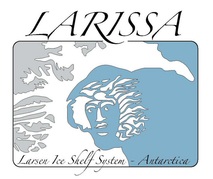
LARISSA - LARsen Ice Shelf System, Antarctica is an NSF-funded initiative, bringing an international, interdisciplinary team together to study the environmental change in Antarctica's Larsen Ice Shelf System and its global change implications. Funded by the National Science Foundation's Antarctic Integrated Systems Science (AISS) department, the LARISSA project began in 2007 in response to the 2002 collapse of the Larsen B Ice Shelf. The sudden disappearance of ice provided an extraordinary opportunity to study an environment and ecosystem in rapid transition. Geoscientists and biologists have worked together for over a decade to understand the events leading up to this collapse and the impacts resulting from it.
The geodetic aspect of the LARISSA project aims to identify which portions of the glacial cover in the Antarctic Peninsula are losing mass to the ocean and at what rate. Research has shown that the Antarctic Peninsula is warming faster than any other region across the earth. After the break- up of the Larsen Ice Shelf in 2002 many regional glaciers began to flow rapidly into the sea. Measurement of the isostatic rebound in this part of Antarctica provides a precise tool with which to base ice mass change. This rebound effect can be measured with very precise techniques using GPS instruments locked into ice free bedrock surrounding the area of interest. Coupled with satellite measurements, a very strong picture emerges about not only current ice dynamics, but past glacial coverage as well.
LARISSA has been able to benefit from technology developed for the POLENET effort, by deploying instrumentation capable of continuous monitoring of bedrock changes along the Antarctic Peninsula. UNAVCO provides significant and ongoing support to the LARISSA project, supplying to date nine continuously operating GPS stations capable of operating year round in the extreme Antarctic environment. Data are telemetered to the UNAVCO archive via Iridium satellite. O&M services and technical support are provided to assure network operability at these remote locations.
Please visit the LARISSA homepage for more information.